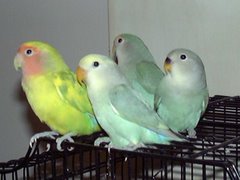Social Characteristics of Peach Faced Lovebirds
As you know already peach faced lovebirds are native of Southwest Africa. At first glance, there appears to be no difference between sexes. An experienced breeder can feel the difference between the pelvic bones which are wider apart in the case of the females of the species.
These lovebirds usually get on well together. They occasionally squabble but these confrontations are rarely serious. They can be kept together with other, spirited species of parakeet. Delicate and smaller birds should not be kept in the same aviary or cage.
Single birds can also be kept provided they are given sufficient attention. You can keep two birds, of whatever sex, in a cage in the living room without any problems arising. However, you should never simply introduce a new bird into a cage containing an existing single bird. The new bird will often be regarded as an intruder and will also be treated as such.
These lovebirds usually get on well together. They occasionally squabble but these confrontations are rarely serious. They can be kept together with other, spirited species of parakeet. Delicate and smaller birds should not be kept in the same aviary or cage.
Single birds can also be kept provided they are given sufficient attention. You can keep two birds, of whatever sex, in a cage in the living room without any problems arising. However, you should never simply introduce a new bird into a cage containing an existing single bird. The new bird will often be regarded as an intruder and will also be treated as such.
It is better to keep both birds in different accommodation or let them get used to each other for quite a long time by placing the cages close together.









 Free Ads For Bloggers
Free Ads For Bloggers

